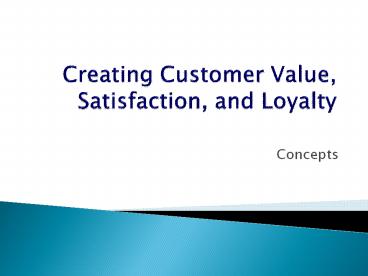Creating Customer Value, Satisfaction, and Loyalty PowerPoint PPT Presentation
1 / 17
Title: Creating Customer Value, Satisfaction, and Loyalty
1
Creating Customer Value, Satisfaction, and
Loyalty
- Concepts
2
Building Customer Value and Satisfaction
- Customer perceived value (CPV)the difference
between the prospective customers evaluation of
all the benefits and all the costs of an offering
and the perceived alternatives.
3
Determinants of Customer Perceived Value (CPV)
- Total customer value
- Product value
- Services value
- Personnel value
- Image value
- Total customer cost
- Monetary cost
- Time cost
- Energy cost
- Psychic cost
4
Loyalty
- A deeply held commitment to re-buy or
re-patronize a preferred product or service in
the future despite situational influences and
marketing efforts having the potential to cause
switching behavior.
5
Satisfaction
- A persons feelings of pleasure or disappointment
that result from comparing a products perceived
performance (or outcome) to expectations.
6
Product and Service Quality
- Quality (or grade) is the totality of features
and characteristics of a product or service that
bear on its ability to satisfy stated or implied
needs. - Forms
- Conformance quality
- Performance quality
7
Marketers Roles in Delivering Quality
- Correctly identifying customers needs and
requirements - Communicate customer expectations properly to
product designers - Be sure orders are filled correctly and on time
- Provide customers with proper instructions,
training, and technical assistance - Stay in touch with customers after the sale
- Gather customer ideas for improvements and convey
them to the appropriate departments
8
Customer Profitability
- A profitable customer is one that over time
yields a revenue stream that exceeds by an
acceptable amount the companys cost stream for
attracting, selling, and servicing that customer.
9
Customer Profitability Analysis (CPA)
- Best conducted with an accounting technique
called Activity-Based Costing (ABC). - Estimate all revenue coming from the customer,
less all costs that go into serving that customer.
10
Customer Lifetime Value (CLV)
- Describes the net present value of the stream of
future profits expected over the customers
lifetime purchases.
11
Cultivating Customer Relationships
- Customer relationship management (CRM) is the
process of carefully managing detailed
information about individual customers and all
customer touch points to maximize customer
loyalty. - Touch pointany occasion on which a customer
encounters the brand and product.
12
CRM Steps
- Identify your prospects and customers
- Differentiate customers in terms of their needs
and their value to your company - Interact with individual customers
- Customize products, services, and messages to
each customer
13
The Customer Development Process
- Potentials
- Prospects
- First-time customers
- Repeat customers
- Clients
- Members
- Advocates
- Partners
14
Building Loyalty
- Interact with customers
- Develop loyalty programs
- Frequency programs
- Club membership programs
- Personalize marketing
- Create institutional ties
15
Customer Database and Database Marketing
- Customer databasean organized collection of
comprehensive information about individual
customers or prospects that is current,
accessible, and actionable for marketing
purposes. - Database marketingthe process of building,
maintaining, and using customer databases and
other databases to make contact, facilitate
transactions, and build customer relationships.
16
Data Warehouse and Datamining
- Data warehouseorganized data where marketers can
capture, query, and analyze it to draw inferences
about an individual customers needs and
responses. - Dataminingstatisticians extract useful
information about individuals, trends, and
segments from the mass of data.
17
Downside of Database Marketing and CRM
- Large investment
- Difficulty in getting everyone to be customer
oriented - Not all customers want an ongoing relationship
- Assumptions behind CRM may not always hold true

